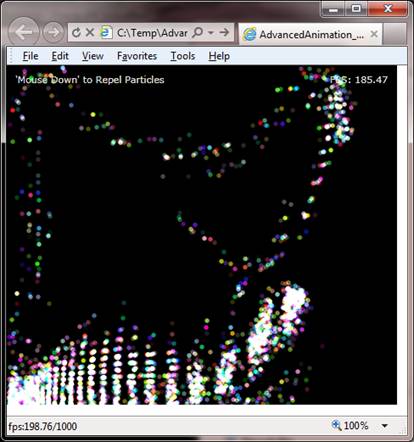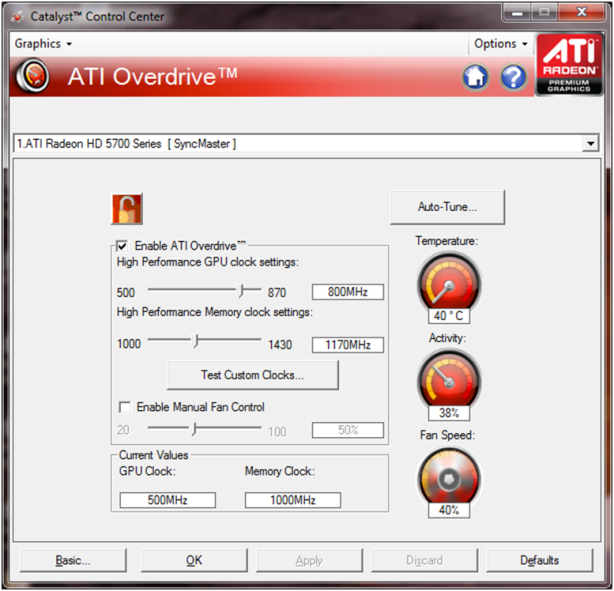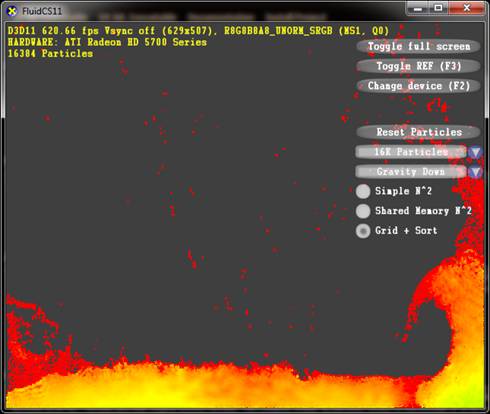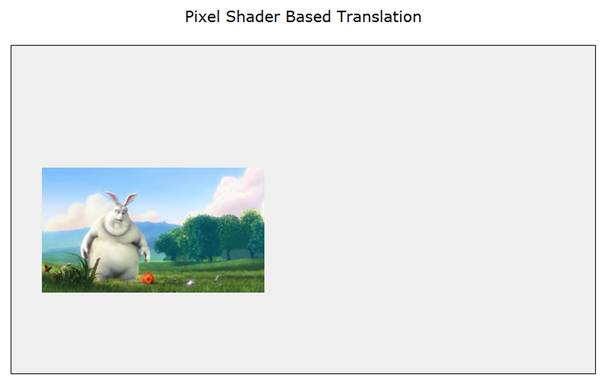Silverlight massive animation performance
As it turns out, Storyboard animations in Silverlight have limited performance capability. Presumably this system has been designed for ease of use and developer / designer productivity. If you want to create massive amounts of animations, like for instance in particle systems, you soon hit the performance limits of the rendering, graphics, animation subsystem.
Hey, that’s interesting!
Of course, now we want to know what the performance limits are, and how we can get around them. When I first hit the aforementioned performance limits, I had no clue as to how to improve performance. In this article you will find some articles I found on the World Wide Web concerning the subject. Great stuff. Some solutions found are about 20 times faster than others, and current developments of Silverlight 5 seems to promise to take it a step further.
Growing trees
The first article encountered was How I let the trees grow by Peter Kuhn. He describes how he ran into performance problems creating a tree that grows by splitting branches into smaller branches, terminating in leaves. At some point he finds his software trying to render over 20k paths, which is ‘massive’ enough to create performance problems. The solution is found in the use of the WriteableBitmapEx CodePlex project. The WriteableBitmapEx contains (among others) a fast Blit operation for copy operations (claimed to be 20-30 times faster than the standard Silverlight operation – I believe it). You can draw on Bitmaps that are not shown yet, thus prepare images for the screen, and then quickly shove them into vision when ready. The (in browser – IE9) solution presented performs well.
What we do not get from this article are clear figures about standard Silverlight performance and improved performance. So let’s discuss another article.
Procedural animations
The WriteableBitmapEx CodePlex project contains a reference to Advanced Animation: Animating 15,000 Visuals in Silverlight by Eric Klimczak. He tells us that if we want to animate ~50 objects concurrently, we need additional performance measures over Storyboards and Timelines. The main performance measures he employs extend the ones mentioned above with: “procedural animations”.
In Procedural Animation within the context of Silverlight you code an Update() and Draw() Loop that is driven by the Windows.Media.CompositionTarget.Rendering event. Essentially, you now code the new position, color, or any other attribute, in the Update() method, and Blit it to the render target in the Draw() method – thus putting it on screen.
This works very well! Eric Klimczak has provided source code with his article, among which a program that animates moving particles that respond quickly to mouse actions (in browser).
For 3000 particles the program renders at ~200 frames per second (FPS), tops, and 15.000(!) particles are rendered at a still pleasant 36 – 46 FPS. I’ve used the Silverlight FPS counter for all Silverlight programs in this article in order to get comparable measurements. See the fps counter in the status bar of the IE screenshot below.

Curiously, there is no maxFrameRate setting in his code. About this maxFrameRate setting the Silverlight documentation writes: “A value of approximately 60 frames-per-second should be reliable on all platforms. The 1000 and 30000 frames-per-second range is where the maximum frame rate could differ between platforms”. So, the obvious step is to set the maxFrameRate to 1.000 – both in code as well as in the html host, which showed a factor 3 performance increase compared to the original article software, for the 3K particle case (screenshot above). The Silverlight Documentation also states that the enableGPUAcceleration setting doesn’t work for the WriteableBitmap, so I skipped that one.
It seems to me that this approach solves most problems. However, procedural animation – a gaming software approach – opens the door to other, even more apt approaches.
Note that this approach does not employ the GPU. All rendering is done using the CPU.
Pixel shaders
An approach that takes performance a step further is Silverlight 3 WriteableBitmap Performance Follow-Up by René Schulte. In this article a number of approaches are compared. All approaches yield comparable results, except the pixel shader approach, which yields a factor ~20 better performance compared to the WriteableBitmap (WOW!).
How does it work? UIElement descendants have an Effect property. You can create custom Effects using a pixel shader written in HLSL (a .fx file) which you compile using e.g. fxc.exe – the DirectX HLSL compiler, or Shazzam. The compiled shader effect is loaded as a resource by a descendant of the ShaderEffect class. The article by René Schulte uses a custom derived class thereby showing how to transfer data into the shader during program execution. The loaded shader should be attached to the UIElement’s Effect Property. The shader will be executed for each pixel to be rendered. This gives you great control over the UIElement. You can modify many attributes of each pixel, for instance color and opacity. Do not forget that dropshadows are implemented as shaders, so you can also duplicate the UIElement visual.
According to René Schulte, the program / pixel shader is not executed on the GPU. That may have been true for Silverlight 3, but in Silverlight 4 it is absolutely possible to put the GPU to work. So, with a bit of tweaking the code here and there we find a maximum performance of >450 FPS.

I’ve registered the GPU invocation for specific tasks using the Catalyst utility of my graphics card, see the fields ‘GPU Clock’ and ‘Memory Clock’ at the bottom of the screen shot below. Regular values are 157 and 300 respectively.

Silverlight 5 Beta and XNA
Recently (April 13th 2011), Silverlight 5 Beta was released. It includes the DrawingSurface control which is a gateway into XNA functionality. A little experimenting reveals that like XNA the default drawing frequency is at 60 FPS, and you can’t seem to get it up by recurring calls to the OnDraw() event handler.
In Silverlight the frequency is raised as described above. In XNA the default of 60 FPS can be lifted by setting both the Game’s object ‘IsFixedTimeStep’ property and the GraphicsDeviceManager’s ‘SynchronizeWithVerticalRetrace’ property to false.
From the MIX demo video it is clear that performance is very good, however, at 60 FPS within Silverlight. The performce step is ‘made’ by the shaders and realized on the GPU. It is currently not clear to me how to measure that performance, so this exercise ends here for now.
Non Silverlight performance
What performance can we expect? Is Silverlight slow, despite the extra tricks? What is the promise hidden in Silverlight 5? We now know that for demanding graphics we can turn to the integration of Silverlight with XNA. XNA, in turn is built upon DirectX.
Below you’ll find a screenshot of a DirectX11 particle demo. For 16K particles (reminiscent of the 15K in the above particle demo) we see a performance of ~620 FPS (not measured with the same frame counter as with the other programs, however), immediately requiring maximum performance from the GPU. For 8K particles performance rises to ~1175 FPS.

One conclusion I would like to draw here is that this performance correlates to the performance of the pixel shader used as a custom Effect. So, we may conclude that the real performance enhancement lies with the use of shaders.
Will this performance hold up in XNA? Yes, a particle simulation in XNA (from the XNA community, with small adaptation) brings us a ~1000 FPS performance, see screenshot.

Conclusion
The above is an exploration of techniques and approaches to realize massive animation performance in Silverlight. It is not a methodological, comparative study. A more rigorous investigation into performance (of what exactly?) might be subject for a later article that builds on the findings presented here.
Here we have learnt that in order to have massive animation in Silverlight we use the WriteableBitmap, the Blit operation from the WriteableBitmapEx Codeplex project, Procedural Animation programming, and pixel shaders (do not forget the enableGPUAcceleration setting, when applicable). We have seen that the exposure of XNA, built on DirectX, in Silverlight will most likely bring us further performance improvements.
Today we can have a very powerful massive animation performance of around 400-500 FPS, and the future is bright.






